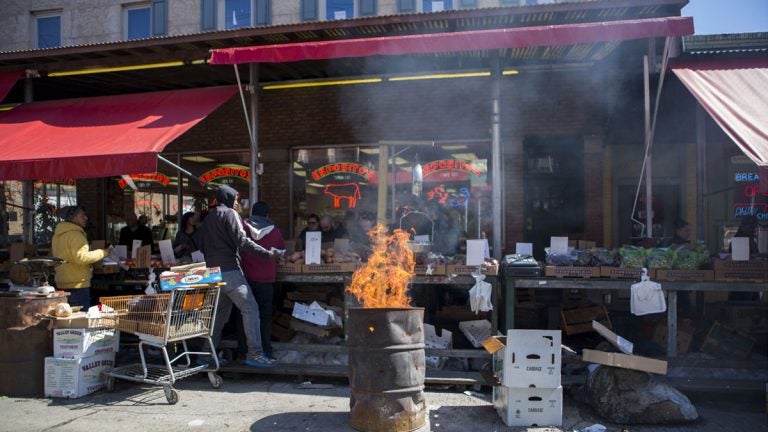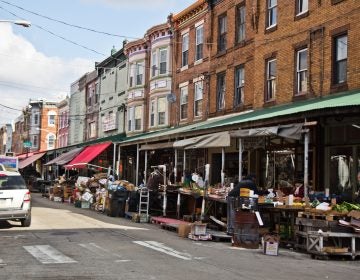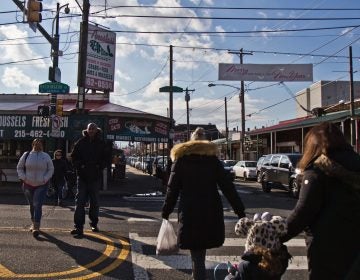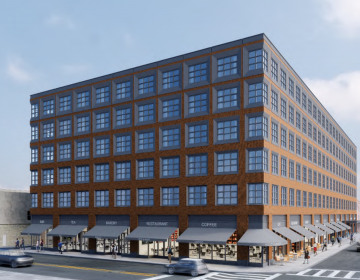New proposal for Italian Market improvement district introduced
On Monday night, Vern Anastasio and his allies officially pitched the “South Philly Market Improvement District.”

Vendors sell produce in the Italian Market neighborhood on South 9th Street in Philadelphia, Pennsylvania on March 22, 2017. (Jessica Kourkounis for WHYY, file)
This article originally appeared on PlanPhilly.
—
A group of South Philadelphia residents fear for the future of the Italian Market and they think that only a business improvement district (BID) can save it — even though a similar campaign failed narrowly in 2016.
“Two years later, we’ve had three butchers shops close, there’s even less foot traffic than in 2016, more businesses are considering closing or moving,” said Vern Anastasio, one of the principal organizers of the new BID campaign. “They can’t give the properties away because no one wants to buy them. And things are getting worse.”
On Monday night, Anastasio and his allies officially rolled out a proposal for the “South Philly Market Improvement District” at a meeting of the Bella Vista Neighbors Association. Business improvement districts (BIDs) levy a small assessment on business property owners within the district boundaries. The revenue collected goes to pay for additional services managed by the BID, usually related to security and cleaning. As proposed, the district would be bounded by Federal, Fitzwater, 8th and 10th streets, with some additional areas of Washington and Christian streets. Though residential property owners will not be asked to pay into the BID, they will benefit from clean-up efforts and improved infrastructure, including lighting, according to the BID organizers.
Anastasio, a neighborhood resident and self-described “scion of a famous Italian Market family,” said that the proposed BID’s principal aim would be to fight blight in the historic food market and the surrounding blocks, a destination for weekend tourists as well as savvy local shoppers unafraid to dodge the occasional trash barrel fire while perusing produce. Street cleaning would be a secondary concern, he said. He projected that $75,000 would be spent on fighting blight in the first year, with roughly $63,000 on cleaning services. There would be no line item for security, he said.
Anastasio said that the blight-fighting funds would be directed to 15 vacant properties on the 9th Street corridor, including some of the market’s iconic curbside stands, and 15 properties on the surrounding blocks.
“These would be real funds offered to a property owner or a stand owner to activate those spaces with no additional funds required from them,” said Anastasio. “Turning those empty curb spaces into parklets, pop- up shops, food trucks, turning bordered up or vacant properties into art installations, or whatever.”
Many of the attendees at Monday night’s meeting asked Anastasio why he thought the time was right to relaunch the BID effort.
Last time around, a loose coalition of older property owners, curbside operators, and many of the Latino-owned businesses below Washington Avenue resisted a proposal that they called unnecessary and costly. A BID must be approved by over a third of affected property owners, and the last effort died when 33.86 percent voted against the proposal.
Learning from their predecessors’ mistakes, the organizers of the current BID drive decided against assessing fees on curbside businesses. These businesses operate on slim margins and formed the backbone of the opposition in 2016. The move will address the concerns of those merchants who feared higher costs and also ensures that they don’t have a vote on the organization’s creation.
Another difference between this effort and the 2016 proposal is an association with the 9th Street Merchants Association, which operates the most famous, tourist-friendly stretch of the market between Christian Street and Washington Avenue and is run largely by the Italian families who have operated businesses on that busy strip for generations, even as newer immigrant groups move into vacated storefronts farther south.
“There is a whole different group of people working on this BID process,” said Michelle Gambino, business manager for the South 9th Street Business Association, who played a key role in the defeated BID effort. “We are not involved at all.”
Anastasio also nodded to contention over the market’s name. Although it is largely still known as the Italian Market, many of the businesses on 9th Street are owned by Latino shopkeepers, and below Washington Avenue, there are far more taquerias than any other type of restaurant.
“We had a lot of folks opposed to this because they felt they didn’t have any skin in it,” said Anastasio. “Many, many of the merchants and property owners south of Washington have felt that they were being asked to buy into this myth of the market being a certain persuasion when in fact its several persuasions.”
Monday night’s meeting was just the first of many that the BID proponents will host with a variety of interest groups, and the general public, before they hope Councilman Mark Squilla will introduce enabling legislation at the end of the year.
No opponents of the BID turned out to the meeting, but Anastasio and Eugene Desyatnik of the Bella Vista Neighbors Association said that they had encountered some continued skepticism.
The 9th Streets Merchants association isn’t thrilled with the new proposal, Anastasio said, and other shopkeepers have asked him why they should listen to concerns of blight from new residents who probably shop at Whole Foods anyway.
But the BID proponents believe a change is needed to save the market and that this slimmed down proposal will be enough to get the idea over the finish line.
“A lot of people who were concerned before may still have concerns, but the hope is you wouldn’t see a movement in the way you did last time,” said Desyatnik.
WHYY is your source for fact-based, in-depth journalism and information. As a nonprofit organization, we rely on financial support from readers like you. Please give today.







